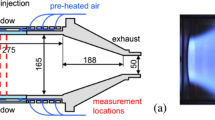Abstract
We examine the role of visualisation in the context of LES simulations of premixed turbulent combustion. The physical processes involved in premixed turbulent combustion are extremely complex, and the modelling of both the turbulence (via LES) and the combustion (via flame-wrinkling models) is difficult. Appropriate visualisation is required to understand the behaviour of the models, and ultimately to understand better the flow processes which are important in many industrial applications. We examine visualisations of two specific cases; simple flame kernel growth in a box of turbulence, and combustion behind a backward-facing step. A number of visualisation techniques are used to produce results that are similar to experimentally determined Schlieren and Mie photography for the flame kernel. In addition, isosurfaces of the reaction regress variable coloured by the laminar flame speed and sub-grid wrinkling are also plotted in an attempt to gain deeper insight into the physics of turbulent combustion in the context of these particular cases. Finally we discuss the role of the WWW in the continuing development of scientific visualisation techniques.
Similar content being viewed by others
References
[Butler:1999] Butler, D. (1999). The writing is on the web for science journals in print. Briefing, Nature, 397:195–200.
[Freitas:1991] Freitas, C. J. (1991). Numerical flow visualization of natural convection flows. American Society of Mechanical Engineers, Fluids Engineering Division 1991, 128: 307–310.
[Fureby et al.:1997] Fureby, C., Tabor, G., Weller, H., and Gosman, A. D. (1997). A comparative study of sub grid scale models in homogeneous isotropic turbulence. Phys. Fluids, 9(5):1416–1429.
[Jeong and Hussain:1995] Jeong, J., and Hussain, F. (1995). On the identification of a vortex. J. Fluid Mech., 285:69–94.
[Kim et al.:1998] Kim, W. W, Menon S., and Mongia H. C. Large Eddy Simulation of Reacting Flow in a Dump Combustor. 29th AIAA Fluid Dynamics Conference, 1998.
[Luo: 1997] Luo, K.H. (1997). Wrinkling of a flame surface in supersonic inhomogeneous turbulence. American Society of Mechanical Engineers, Fluids Engineering Division 1997, 1: 6.
[Moin and Kim:1982] Moin P., Kim J. (1982). Numerical investigation of turbulent channel flow. J. Fluid Mech., 118:341–377
[Pitz and Daily:1983] Pitz, R. W., Daily, J. W. (1983). Combustion in a Turbulent Mixing Layer formed at a Rearward facing Step. AIAA. J., 21(11):1565–1570.
[Weller:1993] Weller, H. (1993). The Development of a New Flame Area Combustion Model Using Conditional Averaging. Thermo-Fluids Section Report TF 9307, Imperial College of Science, Technology and Medicine.
[Weller et al.:1994] Weller, H., Uslu, S., Gosman, A., Maly, R., Herweg, R., and Heel, B. (1994). Prediction of combustion in homogeneouscharge spark-ignition engines. International Symposium COMODIA 94, 163-169. The Japan Society of Mechanical Engineers.
[Weller et al.:1998a] Weller, H. G., Tabor, G., Gosman, A. D., and Fureby, C. (1998a). Application of a flame-wrinkling LES combustion model to a turbulent mixing layer. Twenty-Seventh Symposium (International) on Combustion, 899-907. The Combustion Institute.
[Weller et al.:1998b] Weller, H. G., Tabor, G., Jasak, H., and Fureby, C. (1998b). A tensorial approach to computational continuum mechanics using object orientated techniques. Computers in Physics, 12(6):620–631.
Author information
Authors and Affiliations
Additional information
Gavin Tabor: He took his first degree in Physics, at Cambridge, receiving the B.A. Natural Sciences in 1990. From there he went to Oxford, working for a D.Phil in Astrophysics at the Subdepartment of Theoretical Physics there, which was awarded in 1994. During his time at Oxford he became interested in Computational Fluid Dynamics, and after his doctorate, joined Prof. Gosman’s research group at Imperial College as a postdoctoral researcher, where he has been for the last 5 years. His research interests include multiphase flow, LES, and aeroacoustics.
Ikechuku Kwezi Nwagwe: He received his BEng degree in Aeronautical Engineering from Imperial College, London and followed this with a PhD in fluid dynamics on the stability of laminar flames which he received from the University of Leicester in 1998. He is currently a reserach associate in the Mechanical Engineering Department of Imperial College. His research interests are in LES, unsteady CFD, flow instabilities and combustion.
Henry G. Weller: He received his MEng degree in Chemical Engineering in 1988 from Imperial College of Science, Technology and Medicine, University of London and is currently studying for his Ph.D. in the computational fluid dynamics of turbulent combustion. His research interests are all aspects of computational continuum mechanics including combustion, multi-phase flow, turbulence modelling, transonic-flow, cavitation, non-linear stress-analysis, fluid-structures interaction, magneto-hydrodynamics and software engineering.
David Gosmam: He graduated from the University of British Columbia in 1962 with the degree of Bachelor of Applied Science in Chemical Engineering. He then joined the Mechanical Engineering Department, Imperial College where he performed PhD studies in two-phase flow. Following this he became a member of academic staff and now holds the position of Professor of Computational Fluid Dynamics. He is also a director of a company which produces industrial thermofluids analysis software. He has been active in the field of computational fluid dynamics for more than twenty years, is co-author of several books and around 150 technical papers on the subject, and acts as a consultant in this area to numerous organisations. His main research interests are in the development and application of general prediction methods for steady and unsteady single- or multi-phase flows, with possible accompanying heat and mass transfer.
Rights and permissions
About this article
Cite this article
Tabor, G., Nwagwe, I.K., Weller, H. et al. Visualisation of results from LES of combustion. J Vis 2, 177–184 (1999). https://doi.org/10.1007/BF03181521
Received:
Revised:
Issue Date:
DOI: https://doi.org/10.1007/BF03181521




